

Emotion-sensing technology: 5 companies innovating in the space. Faced with ongoing social isolation, a turbulent economic climate, and continued uncertainty about when life will return to a simulacrum of normalcy—and what that normal will even look like—many adults are exhibiting mounting signs of clinical anxiety and depression during the COVID-19 pandemic, according to data from the U.S.

Census Bureau. As the world’s public health and economic crises give rise to a mental health one, researchers are exploring a bevy of innovative solutions to help people monitor and regulate their emotions. Case in point: Researchers at Dalhousie University in Halifax, Canada, recently created a new app that users can download to keep tabs on their mental well-being. The app analyzes data like users’ voice recordings, keystrokes, and sleep patterns.
How Emotion-Sensing Technology Can Reshape the Workplace. Already a member?
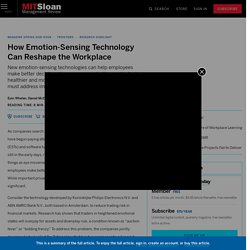
Sign in Not a member? Sign up today. Algorithmic Management: What is It (And What’s Next)? Algorithmic Management: What is It (And What’s Next)?

November 12, 2020 | Artificial Intelligence Blog | Dr Mark van Rijmenam The growth of the “gig economy” in recent years has revolutionised the way that millions of people work. Proponents argue that the gig economy gives people more flexibility and opportunities and lowers barriers of entry to the labour market, while detractors say that it erodes workplace regulations and standards while encouraging businesses to treat workers as increasingly disposable.No matter which side of the debate you fall on, it’s clear that the gig economy is here to stay.
Alibaba facial recognition tech specifically picks out Uighur minority - report. Amazon AI van cameras spark surveillance concerns. (Fixes typo in bullet point) * Amazon is rolling out AI-enabled surveillance cameras in its delivery vans * Drivers and privacy advocates say the company is building a massive mobile surveillance system * Although the system is billed to improve driver safety, some worry it is more about exerting control.
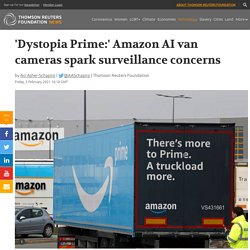
Best employee monitoring software of 2021. The best employee monitoring software can look to improve productivity, improve security, or both.
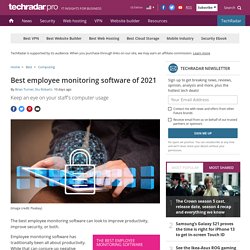
The best employee monitoring software Employee monitoring software has traditionally been all about productivity. While that can conjure up negative images of employee surveillance, not least by ensuring that no one is slacking off, these days it can be more about making sure the right people are doing the right tasks and tracking. The result is that some flavors of employee monitoring can be more like project management suites. Additionally, security and access permissions are also a modern concern, as these days most data and security breaches occur within a company rather than due to hackers. PRIVACY IN THE WORKPLACE. Privacy in the Workplace – Business Ethics.
Learning Objectives By the end of this section, you will be able to: Explain what constitutes a reasonable right to privacy on the jobIdentify management’s responsibilities when monitoring employee behavior at work Employers are justifiably concerned about threats to and in the workplace, such as theft of property, breaches of data security, identity theft, viewing of pornography, inappropriate and/or offensive behavior, violence, drug use, and others.
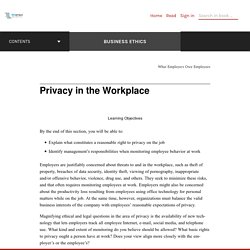
Workplace surveillance may hurt us more than it helps. You can’t fault Amazon’s timing.
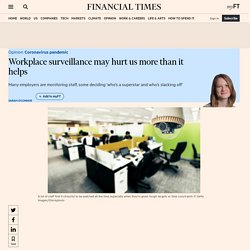
In the middle of a global pandemic, the online retailer has launched a new workplace surveillance tool that could help to slow Covid’s spread. Called AWS Panorama, it uses computer vision technology to analyse footage from security cameras in workplaces. It can detect when employees are not complying with social distancing rules, for example. Amazon, which plans to sell the tool to other employers, says it can improve workplace safety in other ways, too. Workplace surveillance is sparking a cyber rebellion. Welcome to the brave new world of workplace surveillance. Here on Privacy News Online, we write a lot about government surveillance and its impact on privacy.
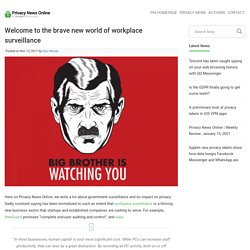
Sadly, constant spying has been normalized to such an extent that workplace surveillance is a thriving new business sector that startups and established companies are rushing to serve. For example, InterGuard promises “complete end-user auditing and control”, and says: “In most businesses, human capital is your most significant cost.
While PCs can increase staff productivity, they can also be a great distraction. By recording all PC activity, both on or off network, Sonar helps you maximize employee productivity by ensuring that your resources are focused on work.” “Capture every keystroke typed even if it is deleted. Labour Party urges UK data watchdog to update its Code of Employment Practices to tackle workplace snooping. Re: Naive Frowned upon and pretty much banned here.
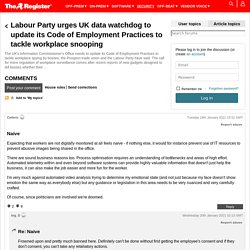
Definitely can't be done without first getting the employee's consent and if they don't consent, you can't take any retaliatory actions. At my employer: We can't monitor email, for example, without first informing the user. If a user is long-term sick, they are sometimes informed that an out-of-office message will be set and their supervisor will be copied in on email, so that nothing important slips by.
Listening in on/recording telephone conversations has very strict rules in Germany, both sides have to agree, before the recording can take place, there can be no automatic recording. Amazon to roll out tools to monitor factory workers and machines. Facial recognition technology in employment: What you need to know. How to Make Artificial Intelligence Less Biased. As artificial intelligence spreads into more areas of public and private life, one thing has become abundantly clear: It can be just as biased as we are.
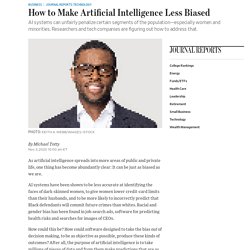
AI systems have been shown to be less accurate at identifying the faces of dark-skinned women, to give women lower credit-card limits than their husbands, and to be more likely to incorrectly predict that Black defendants will commit future crimes than whites. Racial and gender bias has been found in job-search ads, software for predicting health risks and searches for images of CEOs. How could this be? How could software designed to take the bias out of decision making, to be as objective as possible, produce these kinds of outcomes?
After all, the purpose of artificial intelligence is to take millions of pieces of data and from them make predictions that are as error-free as possible. Uber could be forced to collect driver biometrics in London. Uber could soon be required to force drivers to scan their fingerprints or faces in order to continue operating in London, according to sources close to negotiations between the company and the city's transport regulator. The ride-hailing giant, which was handed a temporary licence to continue operating in London in September 2018, is facing a Monday deadline to accept or fight “new terms” imposed by TfL. According to sources, these terms could result in Uber being forced to collect biometric data from drivers to improve safety for passengers.
A document shared by the mayor of London's office outlines a series of requirements that may soon be imposed on Uber, mainly aimed at confirming that a driver using the app is an individual registered and licensed to do so by TfL. According to sources familiar with the negotiations between TfL and Uber, such requirements could include the collection of biometric data. Algorithms at Work: The New Contested Terrain of Control. Microsoft: Protect workers’ privacy in Office 365. Disable the individual worker monitoring features available in Microsoft Office 365, and use aggregate data only. Work with workers and their unions to ensure tools are developed in a responsible and legally compliant way.
Why is this important? Over the last few months, we've been raising concerns about worker surveillance technology and how it is on the rise – often without workers being aware. This week, we got the clearest indication yet that it is going mainstream. When AI Sees a Man, It Thinks 'Official.' A Woman? 'Smile' Between risk and opportunity: employee surveillance policies. Watson Works: A safer way to return to the workplace. Verdantix Infographic How To Lead Your Workplace Through Uncertainity. Automated monitoring of your machine learning models with Amazon SageMaker Model Monitor and sending predictions to human review workflows using Amazon A2I. 2020's Remote Work Statistics (Productivity, Income, Trends)
Review42 Review42 Home > Marketing 28 Need-To-Know Remote Work Statistics Of 2020 By Iva Marinova Last updated: September 24, 2020 Have you ever been curious about the potential of remote work? Well, now is the perfect time to find out! Can Surveillance AI Make the Workplace Safe? 1. S. Bond, “Apple and Google Build Smartphone Tool to Track COVID-19,” NPR, April 10, 2020, www.npr.org. 2.
J. Deloitte rolls out new home monitoring tool. Workplace Surveillance. Workers at a UE represented factory noticed a crew of outside electricians doing a lot of work in the plant. Electronic Performance Monitoring. The Latest on Workplace Monitoring and Surveillance. AMA Staff. How to Monitor Remote Workers — Ethically. Already a member? Factory workers face a major COVID-19 risk. AI can help keep them safe.
When India emerged from COVID-19 lockdown in May, keeping factory workers safe from infection became an urgent priority. Artificial intelligence solutions such as big data analysis can help businesses monitor social distancing and the use of protective gear, and facilitate contact tracing in the event of a worker testing positive. Smart technologies could allow factories, offices, shops and airports to re-open safely. When India emerged from COVID-19 lockdown around the end of May, my company’s artificial intelligence branch received urgent calls from business leaders all over the country and beyond.
PwC under fire for tech that tracks traders’ loo breaks. Amazon faces a more costly workers’ comp classification in Washington state. Just last month, a stunning report showed how Amazon fulfillment centers across the country saw rising injury rates between 2016 and 2019, sourced from internal company data. And now, proposed legislation in Washington state would mean Amazon could pay a higher workers’ compensation premium than other warehouse-owning companies next year. To make this happen, the state wants to put warehouses that function like Amazon’s into a separate risk classification. While the proposed classification for “fulfillment centers” doesn’t say the word Amazon anywhere, how they are defined seems to fit the description of the company: Amazon is currently the only business covered by this new classification, Michael D.
Employee monitoring. Employee monitoring. KPMG reported to accounting watchdog by ex-employee. Basketball tech used to fight Covid-19 on factory floor. What Does It Mean to ‘Solve’ the Problem of Discrimination in Hiring? by Javier Sánchez-Monedero, Lina Dencik, Lilian Edwards. Abstract Discriminatory practices in recruitment and hiring are an ongoing issue that is of concern not just for workplace relations, but also for wider understandings of economic justice and inequality. Yet the way decisions are made on who is eligible for jobs, and why, are rapidly changing with the advent and growth in uptake of automated hiring systems (AHSs) powered by data-driven tools .A recent report estimated that 98% of Fortune 500 companies use Applicant Tracking Systems of some kind in their hiring process. Several of these AHSs claim to detect and mitigate discriminatory practices against protected groups. Yet whilst these tools have a growing user-base around the world, such claims of ‘bias mitigation’ are rarely scrutinised and evaluated, and when done so, have almost exclusively been from a US social and legal perspective.
Meritas Europe & Middle East Guide to Monitoring Employees in the Work Place 2019. Monitoring at the workplace: a new legal framework in Luxembourg. Corporate Surveillance in Everyday Life. Google and Facebook, followed by other large platforms such as Apple, Microsoft, Amazon and Alibaba have unprecedented access to data about the lives of billions of people. Although they have different business models and therefore play different roles in the personal data industry, they have the power to widely dictate the basic parameters of the overall digital markets.
The large platforms mostly restrict how other firms can directly obtain their data; in this way, they force them to utilize the platform’s data on users within their own ecosystems and gather additional data from beyond the platforms’ reach. Although the large multinationals in different sectors that have frequent interactions with hundreds of millions of consumers are in a somewhat similar position, they not only acquire consumer data collected by others, but often also provide data.
P7005 - Standard for Transparent Employer Data Governance. Trade unions urge EU to investigate Amazon effort to spy on workers. European trade union leaders, including three UK unions, have called on the European commission to open an investigation into Amazon’s “potentially illegal” effort to spy on workers for union activities. The heads of some of Europe’s biggest unions, representing more than 12 million workers, wrote to the commission to demand an investigation into Amazon’s work practices across the continent.
The move comes after the US tech firm advertised jobs for which part of the description was investigating the threat of organised labour against the company. Paddy Lillis, the general secretary of Usdaw, along with Mick Rix, a national officer of GMB, and Dave Ward, the general secretary of the Communication Workers Union, are among the 37 signatories to the letter. View of Automating Surveillance. Amazon terminations documents. The workplace-surveillance technology boom. Perils of Amazon robots that hire, fire. How Amazon automatically tracks and fires warehouse workers for ‘productivity’ PressProgress.
Amazon Report Final. Amazon Employee Warns Internal Groups They’re Being Monitored For Labor Organizing. Amazon Employee Warns Internal Groups They’re Being Monitored For Labor Organizing. Vous avez cherché amazon - Planet Labor. Amazon Unveils AI-Powered Social Distancing Surveillance at Warehouses. Amazon introduces 'Distance Assistant' The Emotional Labor of Surveillance: Digital Control in Fast Fashion Retail - Madison Van Oort, 2019. Amazon Report Final. A piece of the puzzle - The Role of the DPO in GDPR Compliance. ¿Qué ocurre en España con los datos biométricos? Autenticación v. Identificación; Equívocos. Don’t forget the right to be forgotten: employer criticised by the Danish DPA. Technology usage and employee behaviour: controversies, complications, and implications in the Nigerian business environment.
Addressing the Harm of Total Surveillance: A Reply to Professor Neil Richards - Harvard Law Review. Wp48 en. Managing Workplace Monitoring and Surveillance. Are enforcing their own contact tracing to track employees. Surveillance in the ‘data-driven’ workplace: is this the new norm? Workplace privacy and surveillance software: What the law says.
DS Workplace Monitoring Surveillance Explainer. 2018 4 3 1 Lockwood. 2018 4 3 1 Lockwood. What are the rules on workplace surveillance? Gender and racial bias found in Amazon’s facial recognition technology. Legal Risks and Recommendations for Employee Workplace Surveillance in the US. Workplace surveillance is becoming the norm; an expert explains a realistic way of handling it. BallWorkplaceSurveillance. The Protests Prove the Need to Regulate Surveillance Tech. Tech Could Be Used to Track Employees—in the Name of Health. The Paradox of Employee Surveillance. Employee surveillance in GDPR era. The workplace-surveillance technology boom. Pandemic incites concerns about data-sharing overreach. New Facebook Tool Allows Employers to Suppress "Unionize" in Workplace Chat.
Yuval Noah Harari: the world after coronavirus. What are the rules on workplace surveillance? Netherlands: AP issues €725,000 fine for processing employee fingerprints. Boete voor bedrijf voor verwerken vingerafdrukken werknemers. Employee surveillance – how far is too far? Temperature Scans in the Workplace - Guidance.